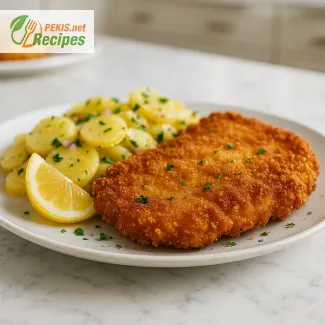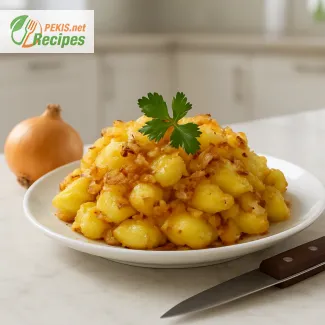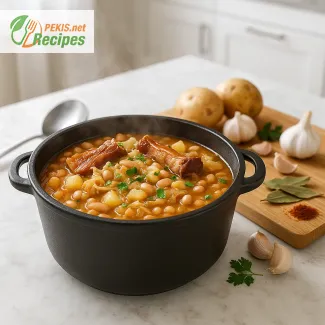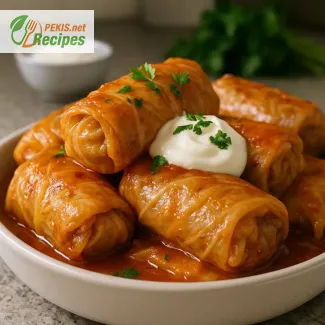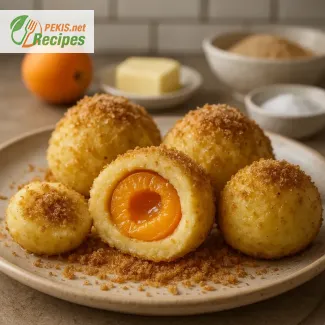Perfect Pan-Seared Pork Ribs with Crispy Finish and Savoury Sauce serve 4 portions, ready in 20 minutes prep, 40 minutes cook, and 60 minutes total. The pork ribs are seared in a hot skillet until golden and crispy, then gently simmered with garlic, rosemary, honey, and soy sauce for a deep, caramelized flavor. This method creates tender, juicy meat with a rich glaze — no oven needed. The ribs can be stored for up to two days and reheated slowly to keep their crispy edges and succulent texture, making them ideal for both weekday dinners and weekend comfort meals.
Cooking pork ribs in a skillet has become one of those recipes that always delivers — full of flavor, aroma, and that satisfying balance between crispy edges and tender meat. Over the years, experimenting with different cuts and heat levels has taught that patience and steady searing make all the difference. The sound of sizzling ribs and the aroma of garlic and rosemary blending with the melting butter always sets the tone for a perfect meal.
PEKIS – a professional chef and recipe developer with over 25 years of experience in cooking and baking, specialized in European and international cuisine.
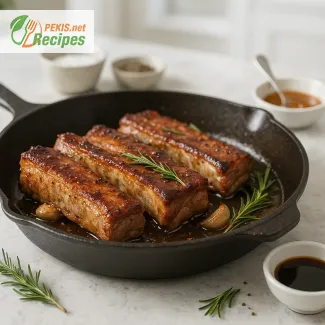
Pan-Seared Pork Ribs – Tender Inside, Crispy on the Outside
A comforting dish full of rustic charm and rich homemade flavor
When the sizzle of pork ribs meets the heat of a cast-iron pan, something magical happens. The fat renders slowly, coating the meat until it becomes beautifully caramelized and crisp at the edges. Every bite offers the perfect contrast — a tender interior and a golden, savory crust kissed by the pan’s heat. This simple yet deeply satisfying recipe brings out the pure essence of pork, seasoned with nothing more than salt, pepper, and time.
Across many kitchens, pan-seared ribs are a symbol of comfort — the kind of dish that fills the air with warmth and nostalgia. Instead of relying on long oven roasts or smoky barbecues, this method delivers succulent results in less time, allowing the natural flavors of the meat to shine.
A brief note on origin and tradition
While pork ribs are loved worldwide, the idea of pan-searing them traces its roots to European country kitchens, where cooks often worked with limited equipment but infinite creativity. Without modern ovens or grills, the frying pan was the heart of the home, and it produced dishes that were both practical and full of character. Over time, these quick-cooked ribs became a weeknight staple — rich, golden, and irresistibly juicy.
Why you’ll love this recipe
- Crispy outside, juicy inside – the perfect texture contrast in every bite.
- Quick and easy – no oven needed, just your favorite heavy skillet.
- Rich caramelized flavor – the pan creates deep, savory tones that roasting can’t replicate.
- Flexible seasoning – customize it with herbs, garlic, or smoky paprika.
- Perfect for any season – pairs beautifully with potatoes, salads, or fresh bread.
The essence of perfect searing
Good pan-seared ribs start with the right balance of heat and patience. The fat must melt gradually, allowing the meat to brown evenly without drying out. A cast-iron or heavy-bottomed skillet distributes heat perfectly, locking in moisture while building a deep mahogany crust. A touch of oil helps develop that signature crispness, while gentle basting ensures a juicy center.
The result is a dish that’s simple yet indulgent — a celebration of texture, aroma, and flavor. Each rib glistens with a golden sheen, its aroma earthy and inviting.
Ingredients that make the difference
Every element contributes to the balance of this dish:
- Pork ribs – marbled with fat, they remain moist and flavorful.
- Salt and pepper – the foundation of taste that enhances natural sweetness.
- Garlic or rosemary – for a rustic aromatic note that complements the richness.
- Butter or olive oil – helps achieve a glossy, golden crust.
You can experiment with spice blends — from smoky paprika to mustard seeds or a hint of honey glaze for a delicate sweetness.
Storing and preparing ahead
Pan-seared ribs are best served fresh, but they can be stored for up to two days in the refrigerator. To reheat, place them in a covered skillet with a splash of water or broth, warming slowly until tender. This keeps them juicy without losing the crispy edges. Marinating the ribs overnight in your favorite seasoning blend also enhances their depth of flavor.
Complementary recipes you might enjoy
If you love hearty dishes like this, explore these comforting pairings available on PEKIS Recipes:
- Perfect Pan-Fried Potatoes with Onion – Boiled First for Extra Flavor
- Classic Apple Strudel with Homemade Vanilla Sauce Recipe
These additions complete the dining experience — crispy potatoes make a rustic side, while the warm strudel offers a sweet, fragrant ending.
Creative variations
- Spicy ribs – add chili flakes or cayenne for a fiery kick.
- Honey-glazed ribs – brush with honey and soy sauce during the final minutes for a sticky-sweet layer.
- Herb-infused version – marinate with thyme, oregano, and a drizzle of olive oil.
- Smoky style – sprinkle with smoked paprika or liquid smoke for outdoor barbecue flavor indoors.
Flavor pairing and serving ideas
Serve these ribs hot from the pan with pan-fried potatoes, buttered corn, or a fresh coleslaw for balance. A cold beer or glass of red wine completes the moment — rich, comforting, and timeless.
This dish embodies the best of home-style cooking: minimal effort, maximum satisfaction, and a depth of flavor that comes only from the gentle hiss of meat in a hot pan.
- Pat dry the pork ribs with paper towels to remove excess moisture. Cut them into manageable portions if needed.
- Season all sides evenly with salt, pepper, and paprika powder, then let rest for 10–15 minutes to allow the seasoning to absorb.
- Heat olive oil in a heavy skillet over medium-high heat until it begins to shimmer.
- Add the ribs in a single layer and sear for about 3–4 minutes per side, until a golden-brown crust forms. Avoid overcrowding the pan to maintain even browning.
- Reduce heat to medium, add butter, garlic, and rosemary. Baste the ribs with the melted butter for extra flavor and moisture.
- Once well browned, pour in water or broth to deglaze the pan, scraping the flavorful bits from the bottom. Cover with a lid and let simmer gently for 25–30 minutes until the meat becomes tender.
- Mix honey and soy sauce in a small bowl. Brush this glaze onto the ribs during the final 5 minutes of cooking for a shiny, caramelized finish.
- Remove from heat and let rest for 5 minutes before serving. This allows the juices to redistribute, keeping the ribs moist.
- Serve with side dishes like pan-fried potatoes or fresh coleslaw.
FAQ questionHow long should I sear pork ribs in a pan?
For perfectly crispy edges and a tender interior, sear each side of the pork ribs for about 3–4 minutes on medium-high heat. This creates a golden-brown crust while locking in the natural juices. Avoid overcrowding the pan to ensure even browning and consistent texture.
FAQ questionCan I cook pan-seared ribs without butter?
Yes, olive oil alone can be used for searing, but adding butter enhances the flavor and gives a richer, slightly nutty aroma. Basting with butter also helps keep the ribs moist and glossy during cooking.
FAQ questionWhat is the best way to glaze ribs in a skillet?
Mix honey and soy sauce in a small bowl and brush it onto the ribs during the final 5 minutes of cooking. This creates a shiny, caramelized layer without burning. You can also adjust the glaze by adding spices like paprika or chili flakes for extra flavor.
FAQ questionHow do I know when the ribs are fully cooked?
The ribs are done when the meat is tender and starts to slightly pull away from the bones. You can also check by piercing with a fork; it should slide in easily. The pan glaze and simmering liquid should reduce slightly, coating the ribs with a rich, savory layer.
FAQ questionCan pan-seared ribs be stored and reheated?
Yes, cooked ribs can be stored in the refrigerator for up to two days. Reheat slowly in a skillet with a splash of water or broth to keep them moist while preserving the crispy edges. Avoid microwaving at high power, as it can make the crust soggy.
FAQ questionWhat sides pair best with pan-seared ribs?
They pair beautifully with pan-fried potatoes, buttered corn, coleslaw, or a fresh salad. The sides should complement the rich, savory flavor of the ribs without overpowering them.
FAQ questionIs it possible to make the ribs spicy?
Absolutely. Add chili flakes, cayenne, or smoked paprika to the seasoning mix or glaze to introduce a spicy kick that balances the natural sweetness of honey and the umami of soy sauce.
FAQ questionCan I prepare the ribs ahead of time?
Yes, marinate the ribs in advance with your favorite herbs and spices. This enhances the depth of flavor and allows for faster cooking when ready to sear. Just let them come to room temperature before pan-searing for even cooking and crispiness.
Pan-seared pork ribs deliver a perfect balance of textures — the crispy, caramelized exterior contrasts beautifully with the tender, juicy interior. Every bite showcases the richness of the meat, enhanced by the subtle aroma of garlic, rosemary, and butter, and the gentle sweetness of honey-soy glaze. The method emphasizes control over heat and timing, allowing flavors to develop naturally while maintaining the succulence of the ribs.
Pairing the ribs with pan-fried potatoes, fresh coleslaw, or buttered corn creates a complete dining experience, balancing the richness of the meat with complementary textures and flavors. Small adjustments, like adding spices or herbs to the glaze, allow personalization without compromising the essential harmony of the dish.
Preparation and storage are simple: ribs can be marinated ahead of time for deeper flavor or stored for short periods while retaining their crispy edges and moist interior upon gentle reheating. This flexibility makes them suitable for both casual weeknight dinners and special gatherings.
The appeal of pan-seared ribs lies not just in taste but in visual presentation and aroma — a sizzling skillet, the golden crust, and the fragrant glaze create an experience that engages the senses before the first bite. This recipe highlights classic techniques elevated with attention to detail, ensuring consistent results that satisfy both home cooks and experienced chefs.
Mastering this dish demonstrates the art of balancing heat, seasoning, and timing, resulting in a memorable and flavorful meal. Every step emphasizes the natural taste of the pork, making it a versatile centerpiece for any table and a dish that invites creativity and enjoyment.
Allergens present in the recipe:
- Soy – present in soy sauce.
- Milk – present in butter.
- Gluten – may be present if soy sauce is not gluten-free.
Substitution tips for allergens and gluten:
- Replace soy sauce with tamari or coconut aminos for a gluten-free version.
- Use vegan butter or olive oil to avoid dairy.
- Always check product labels for cross-contamination if sensitive to gluten.
- Vitamin B1 (Thiamine) – 0.8 mg – supports energy metabolism.
- Vitamin B6 – 0.6 mg – aids in protein digestion and nervous system function.
- Iron – 2.4 mg – contributes to oxygen transport in blood.
- Zinc – 3.1 mg – strengthens immune response and aids in tissue repair.
- Phosphorus – 290 mg – supports bone structure and energy storage.
- Potassium – 420 mg – helps maintain normal muscle and heart function.
- Rosemary extract compounds – 0.3 mg – protect cells from oxidative stress.
- Vitamin E – 1.2 mg – defends lipids in cells from free radicals.
- Polyphenols (from honey and olive oil) – 2.1 mg – reduce inflammation and support heart health.
- Carotenoids (from paprika) – 0.4 mg – support vision and skin health.
